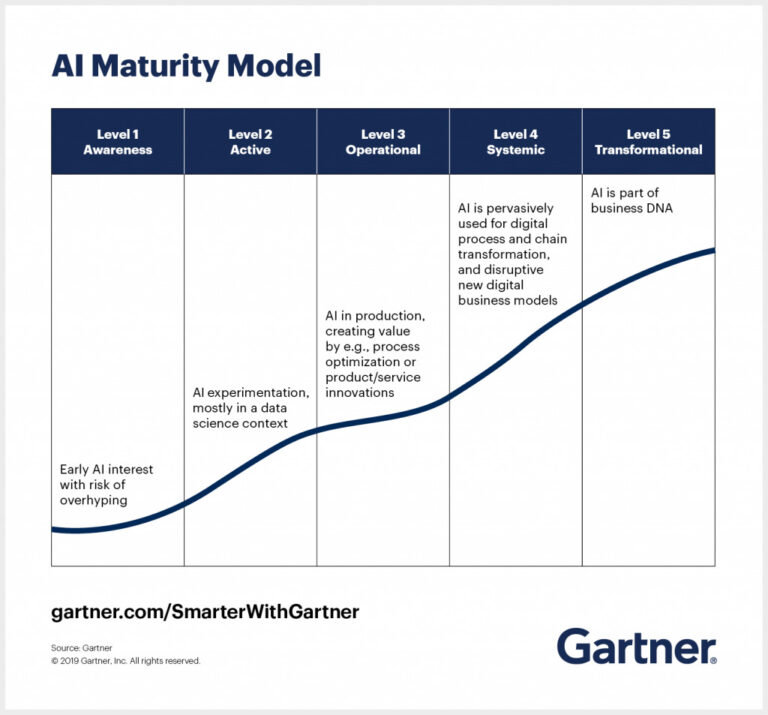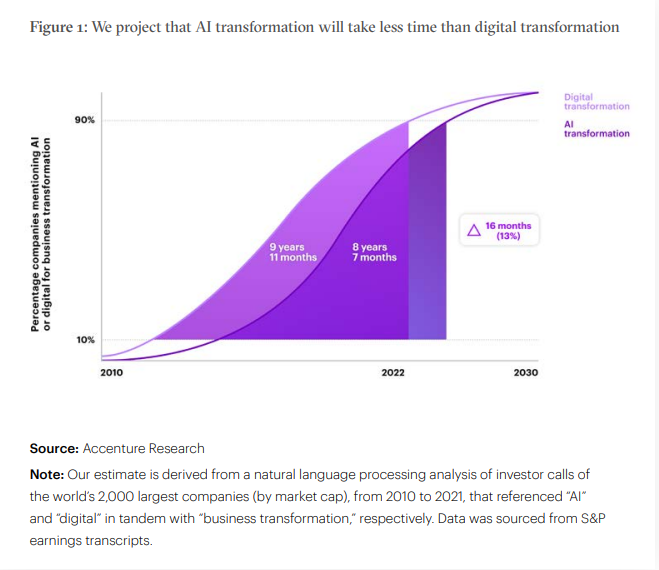For sure, you heard about AI being the trend of the hour. You must have tried some software already. It would be really difficult to miss out on the hype around ChatGPT and Midjourney.
Thing is, this kind of tech is way more powerful than what you saw testing Gen AI. The opportunity in Artificial Intelligence is truly remarkable. 80% of the companies say, they are either already using or are set to use this kind of solutions in the future.
Having that in mind, let’s talk about AI Maturity.
Stay, if you want to know how to catch up with the most advanced AI achievers. Let’s see if there is still a chance to join the party.
What Is AI Maturity?
AI maturity measures the degree to which organizations have mastered AI-related capabilities in the right combination to achieve high performance for customers, shareholders, and employees.
Accenture
Would you say you are up-to-speed with the newest technology?
Turns out it can be precisely measured. AI Maturity index will tell you how good you are at using artificial intelligence.
Let’s find out how you rank and what else can you do to upgrade customer, stakeholder, and employee experience with AI.

Levels Of AI Maturity
Gartner’s recipe for AI maturity consists of 5 elements:
Level 1. Awareness
Companies at this stage are aware of the new technology. They are eager to implement AI, come up with ideas, but haven’t used it yet.
If you share their spot, channel your excitement into trying out possibly useful solutions. Find out more about AI capabilities. Research the market and sign up for available trials. You need a clearer understanding of what AI is and what it can do. You should invest in training programs and workshops to educate your employees on AI and its potential benefits. It is also crucial to identify the specific problems that AI can solve in your own industry and business operations.
Level 2. Active
At the active stage of the process, organizations are starting to experiment with AI. They have identified specific use cases where AI can provide value and are investing in proof-of-concept projects.
The focus in this stage is on learning and experimentation. These companies are playing with AI a lot. They are trying out different solutions and may have even implemented a few models into their processes.
In case you already tested some software, and are at the active stage of AI Maturity, it’s time to make a plan for extensive AI implementation. To move to the next level, you need to build a data infrastructure that enables AI applications to access data in a reliable manner. You should also start investing in resources to develop and train AI models.
Level 3. Operational
At the operational stage, AI is integrated into the organization’s business operations. It is being used to solve real business problems and is providing value to the organization. The focus in this stage is on scaling and optimization.
Companies that reached this level have adopted machine learning into their day-to-day functions. Likely, they also have a team and the infrastructure set up, and they are using AI to assist with some information processing.
If you’ve reached this level, it’s time to upgrade your business model. Modern technology has the potential to activate new, disruptive strategies. It can influence the efficiency of your processes and create value for your customers like they haven’t seen before. To move to the next stage, you need to invest in more advanced AI technologies such as Natural Language Processing (NLP) and Computer Vision. You should also focus on improving the accuracy and efficiency of your AI models.
Level 4. Systemic
At this stage of AI Maturity, you’re almost a pro. The only thing left to do is to inject this kind of mindset into your organization’s DNA. If you want to get to a point of full AI Maturity, apply the new approach globally, into every little aspect of your business.
Companies at this level are using machine learning to disrupt former business models. They reshape the way they’ve operated before and create new AI-driven strategies.
To reach the transformative stage, you need to build a culture of innovation and be open to change. You should be willing to take risks and experiment with new AI technologies and business models. You should also invest in AI research to stay ahead of the curve.
Level 5. Transformational
At this stage, AI is no longer just a tool for solving specific business problems, but a driver of business transformation. It is being used to create new business models and revenue streams. The focus in this stage is on innovation and disruption. Companies at this level use AI every day and universally. Machine learning and AI-driven data processing are central to the customer experience they offer.
Not many companies have reached this point. Accenture says that 64% of firms are still testing the AI waters. Only 11% have advanced their AI maturity enough to achieve superior performance and growth. It looks like it is an exclusive club. If you’re one of the few, keep up the good work and be sure others are determined to catch up.
Why AI Maturity Matters?
Looks like switching to AI will take less time than digital transformation. The graph below shows that we need 16 months less to reach the same level of AI Maturity than we needed for going digital.

It definitely matters to be on time before the AI train leaves the station. Chasing over the last car is going to be difficult and will potentially cost you your clients.
Customers clearly favor AI-driven experiences over traditional process. They prefer personalized communication and individually crafted offerings. Today’s technology can support companies in delivering that. Without effort, on point and at the right hour.
Thus, failing to adopt AI (at any maturity level) in the next few months, is probably the number one thing to avoid in 2024.
If you want to gain any advantage, you must start your journey with AI solutions immediately.
How To Ensure The Success Of AI Implementation?
AI seems groundbreaking today, but will soon become standard practice. To outperform your competitors, you should begin crafting your AI implementation strategy almost immediately after finishing this article.
The urgency is key to make sure you don’t miss out on the opportunity. But there are ways to do it right and to do it wrong. Accenture mentions 4 success factors to AI implementation strategy. If you want to ensure that you get results, consider:
Success Factor 1: AI as a Priority
To ensure the success of AI implementation, you must make AI your priority. This involves a top-down approach where leaders actively promote and support AI initiatives.
78% of Achievers have CEO and senior sponsorship.
Accenture
Leadership should establish a clear vision and strategy for AI integration, outlining the expected outcomes and benefits. Only by prioritizing AI, you will be able to succesfully secure the necessary resources, budget, and talent required for moneymaking implementation.
Success Factor 2: Investing in New Talent
AI implementation demands a skilled workforce with expertise in data science, machine learning, and AI technologies. Investing in new talent is crucial to ensure the success of AI initiatives.
If you want to succeed, focus on attracting and hiring individuals with a strong background in AI and data analytics. These experts can help you harness the potential of AI and navigate complex challenges related to data management, model development, and optimization.
Furthermore, ongoing training and development programs can help you upskill existing employees to stay ahead in the rapidly evolving AI landscape.
78% of Achievers have mandatory AI trainings for most employees, from product development engineers to C-suite executives.
Accenture
Success Factor 3: Right AI Tools
Another thing, vital for successful AI implementation, is choosing the right tools.
You should carefully evaluate your specific needs and select tools that align with your business goals and processes. Whether it’s off-the-shelf solutions or custom-built models, choosing the right AI tools requires a comprehensive understanding of various factors, such as scalability, compatibility, ease of use, and security. Collaborating with AI vendors, consultants, and domain experts can help you make informed decisions about the tools that best suit your requirements.
Success Factor 4: Responsible Architecture
AI implementation should be guided by responsible architecture. This involves adopting ethical practices, ensuring data privacy, and promoting transparency and explainability in AI systems.
You should establish robust data governance frameworks to govern the collection, storage, and processing of data.
Additionally, you should implement bias detection and moderation techniques in AI models to ensure fairness and avoid discriminatory outcomes.
It’s also essential to prioritize the security of AI systems and protect against potential vulnerabilities or attacks.
Success Factor 5: Prioritizing AI Investments
Successful companies invest more in AI because they understand that it is an ongoing journey with no endpoint. They recognize that there is always room for improvement and that the quality of investments is as important as the quantity. They also know that their AI transformation is just beginning and they have only scratched the surface of its potential.
In 2018, AI Achievers in Europe devoted 14% of their total technology budgets to AI, while in 2021 they devoted 27%. In 2024, they plan to devote 33%.
Accenture
To effectively execute short- and long-term AI projects, you should allocate sufficient resources, both financial and human. This requires regular budgeting and resource planning, considering factors like data acquisition and management, hardware infrastructure, software licenses, and continuous training and development of AI talent.
How to use AI to drive more business?
To use AI to drive more business, you need to identify the areas where it can add value. You also need to choose the right tools and platforms that suit your needs and budget.
AI is a powerful technology that can help businesses grow in many ways, but it is not a magic solution that solves things entirely on its own, without human touch. You still need to have a clear vision, strategy, and execution plan. You also need to monitor and evaluate the performance and impact of AI on your business outcomes. By using AI wisely and ethically, you can leverage its potential to drive more business growth.
Some examples of how business are using AI to maximize the ROI are:
Closing argument
As we look ahead to the future, the adoption of AI is not an option; it’s a necessity. Customers increasingly favor AI-driven experiences. This, above all, is the reason to pay attention to AI development. Whether you’re a pioneer or a latecomer to the show, the time to invest in AI is now. It’s your ticket to driving more business, enhancing customer experiences, and staying ahead in an ever-competitive market. Use it wisely and you might get to the destination before any competitor will.
Get in touch if you’d like some help with reaching AI Maturity and driving more business with AI.
